Abstract
Inhibition of the steady-state generation of Escherichia coli by the bacteriostatic antibiotic novobiocin is linearly related to drug concentration in the range of 0 to 30 μg/ml. Increased cell sizes result because the drug inhibits cell division. The generation rate dependence on drug concentration depends on the nonionized fraction of novobiocin and is invariant with inoculum size or medium composition. However, the antibacterial activity of novobiocin decreases as the concentration of nutrients and Mg2+ increases, although the inhibitory action of novobiocin on generation rate remains unchanged for concentrations of Mg2+ above 8.1 × 10−4 M. Novobiocin is synergistic in combinations with tetracycline in broth, but not when the Mg2+ was maintained at 4.05 × 10−3 M. Combinations of novobiocin with the 50S ribosomal subunit inhibitors chloramphenicol, erythromycin, or lincomycin are antagonistic, and the degree of growth inhibition is determined only by that component of the binary combination that would have the greater potency if it were acting alone.
Full text
PDF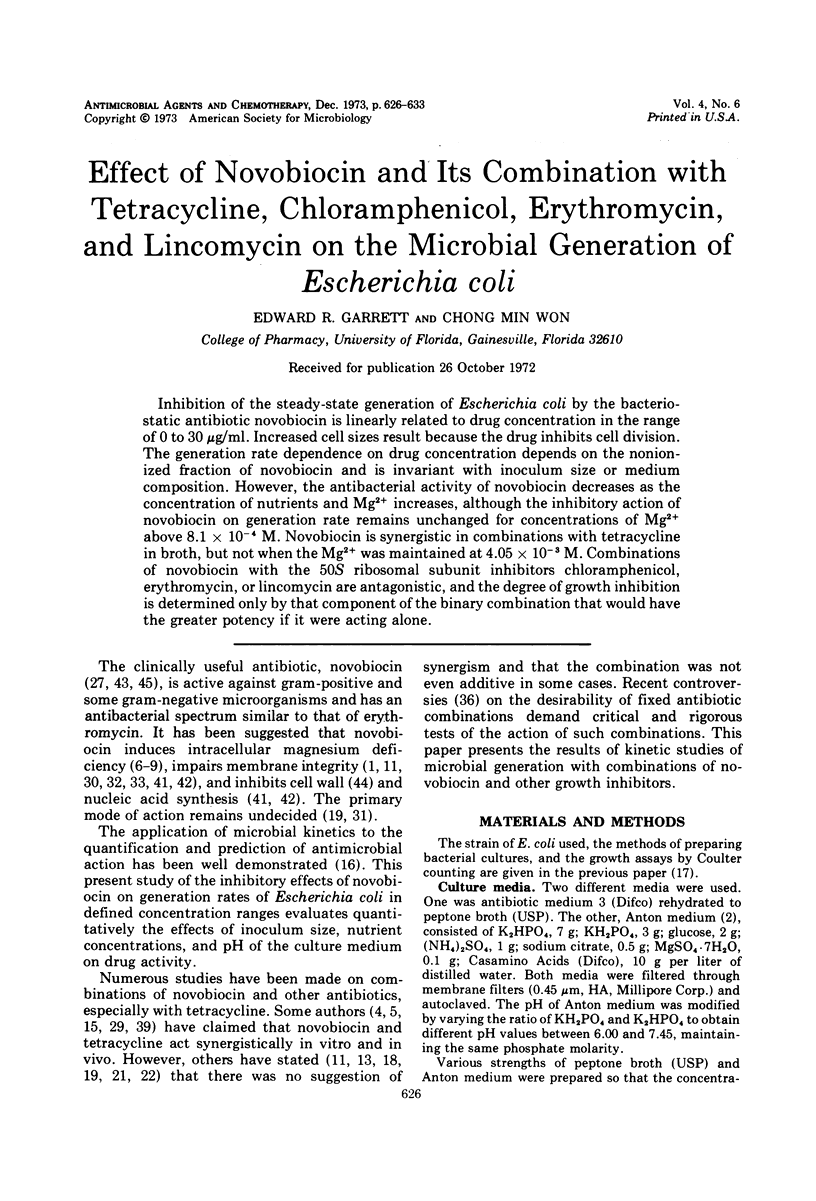
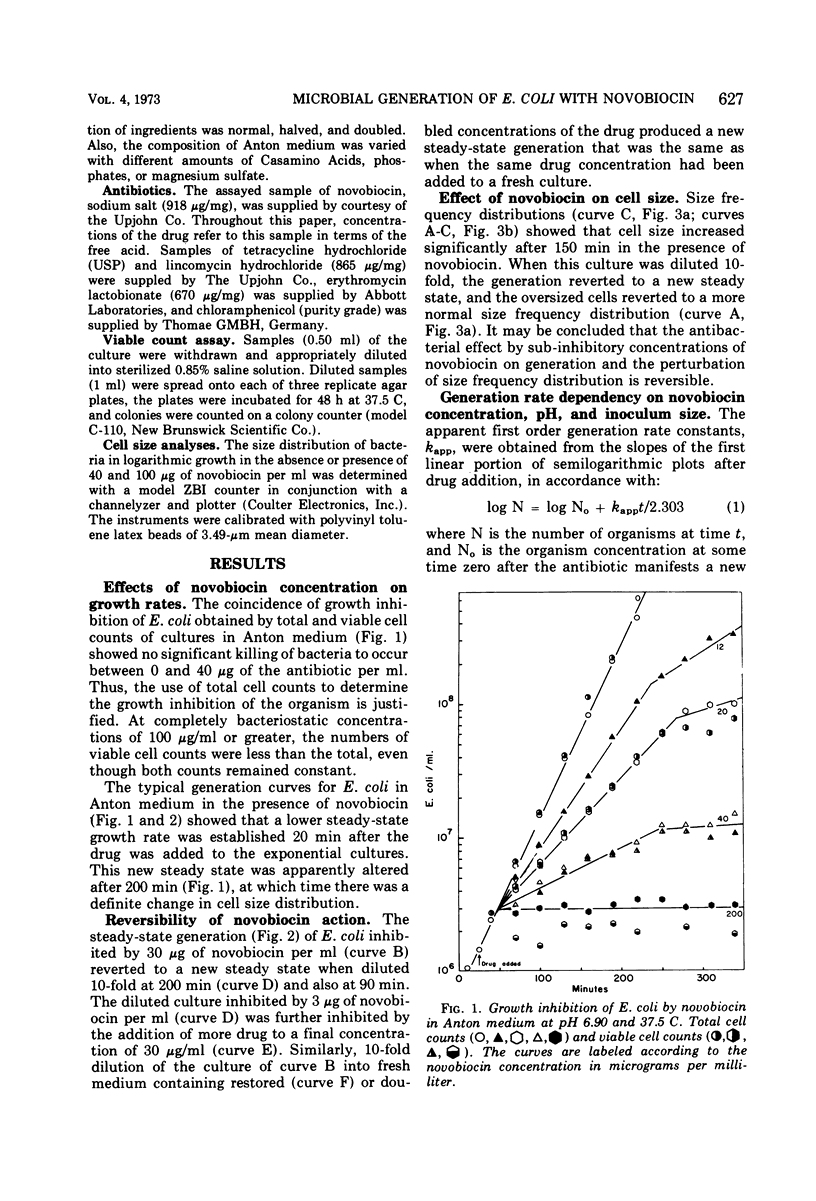
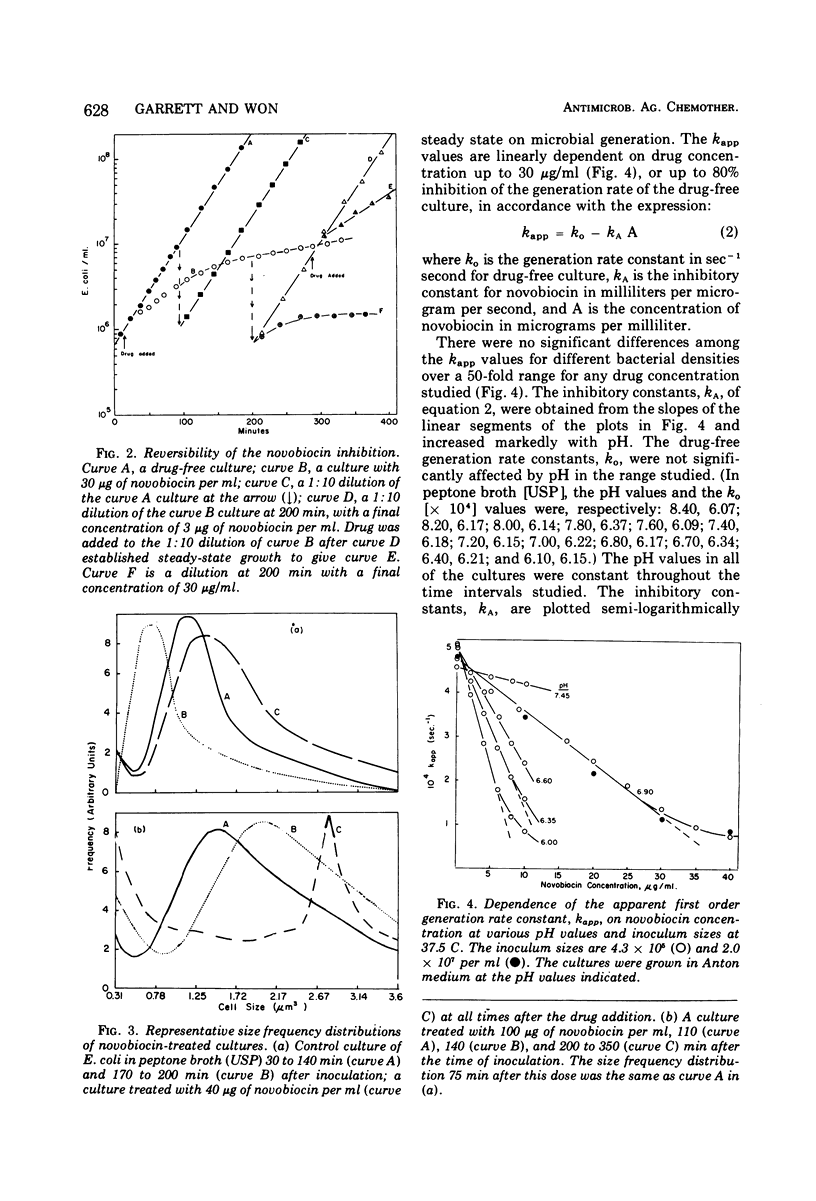
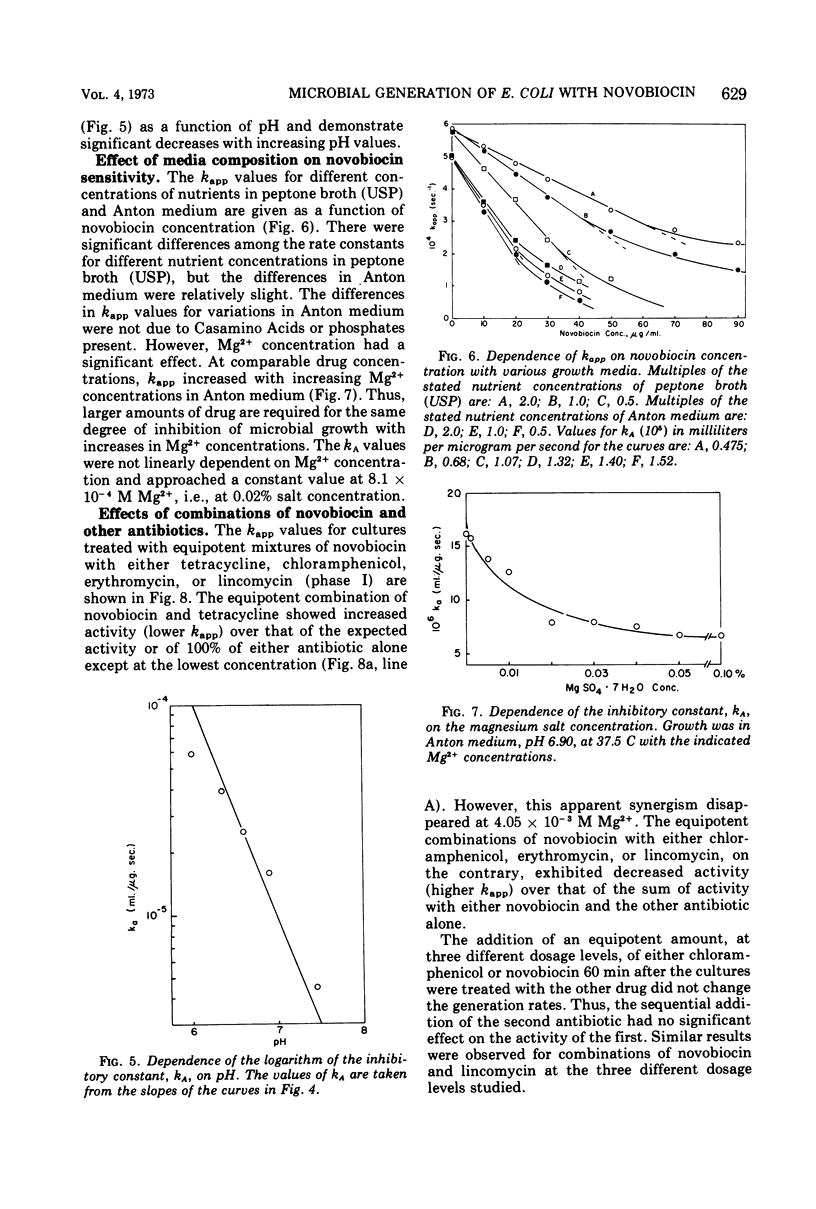
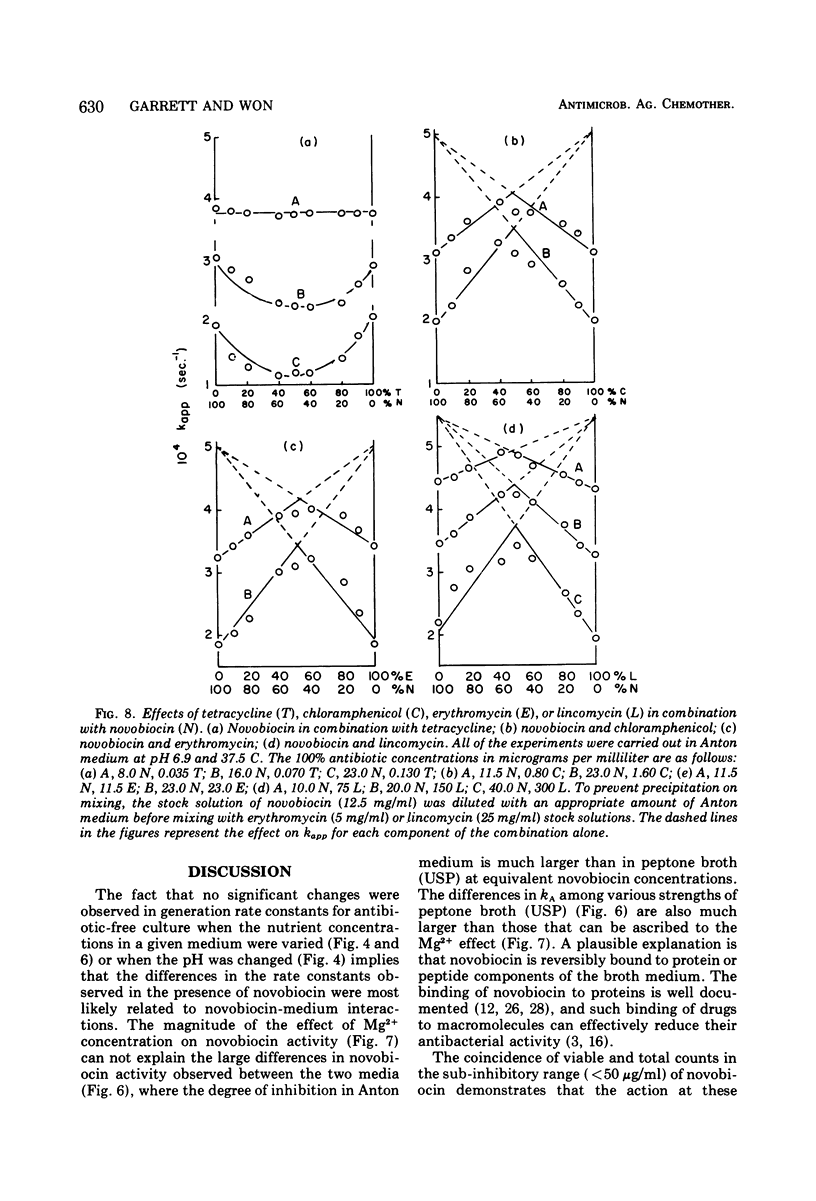
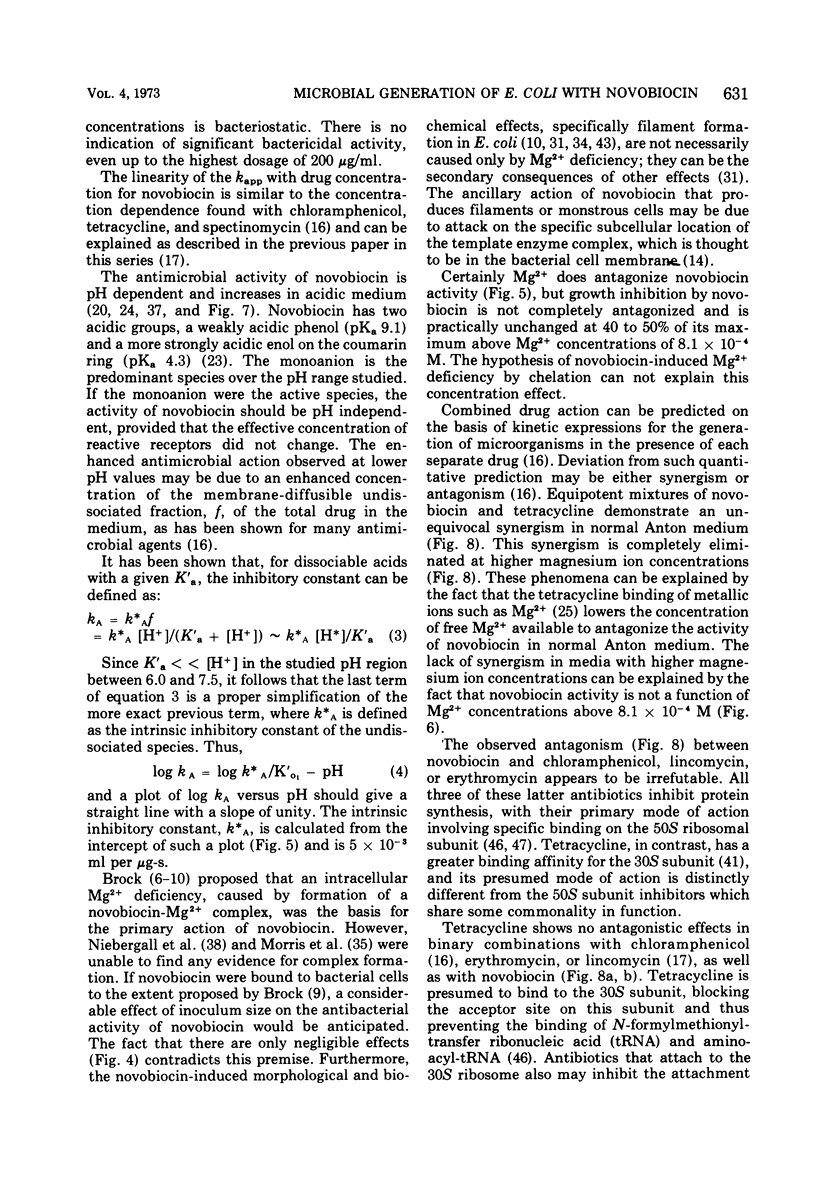
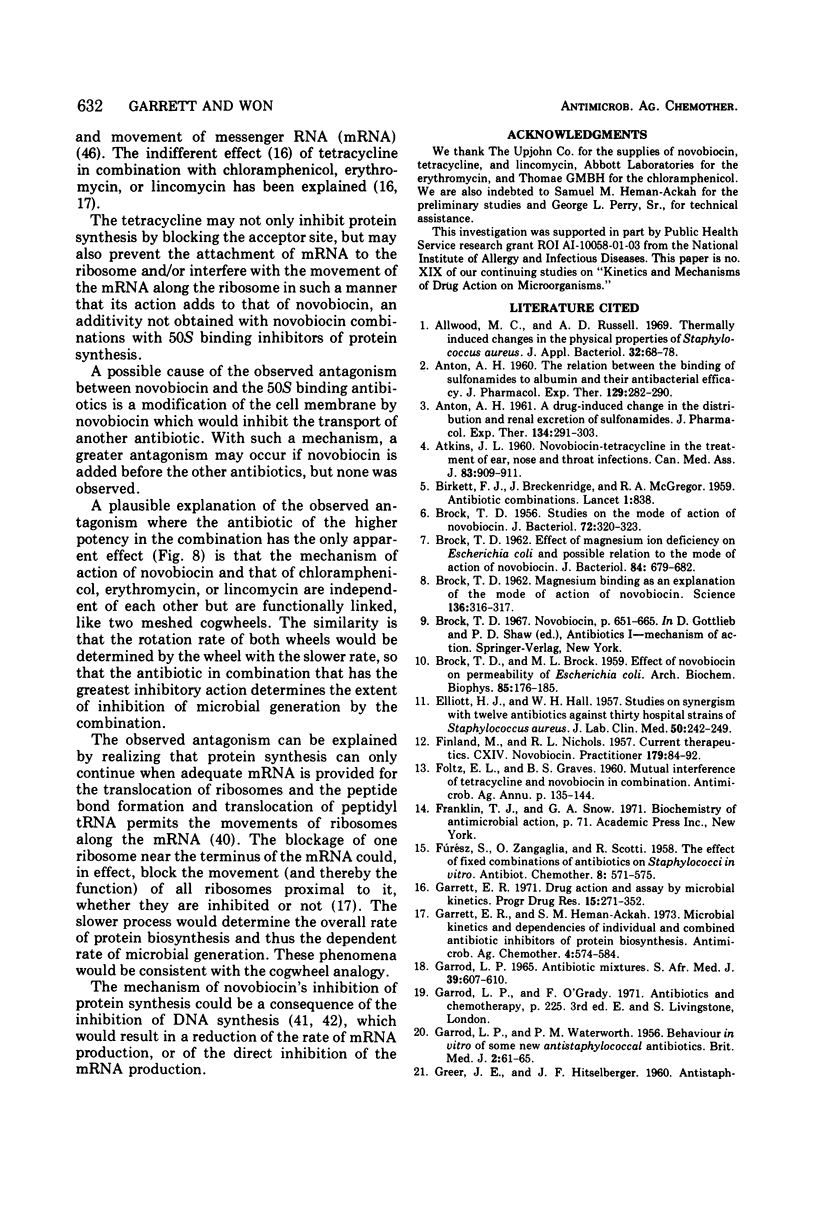
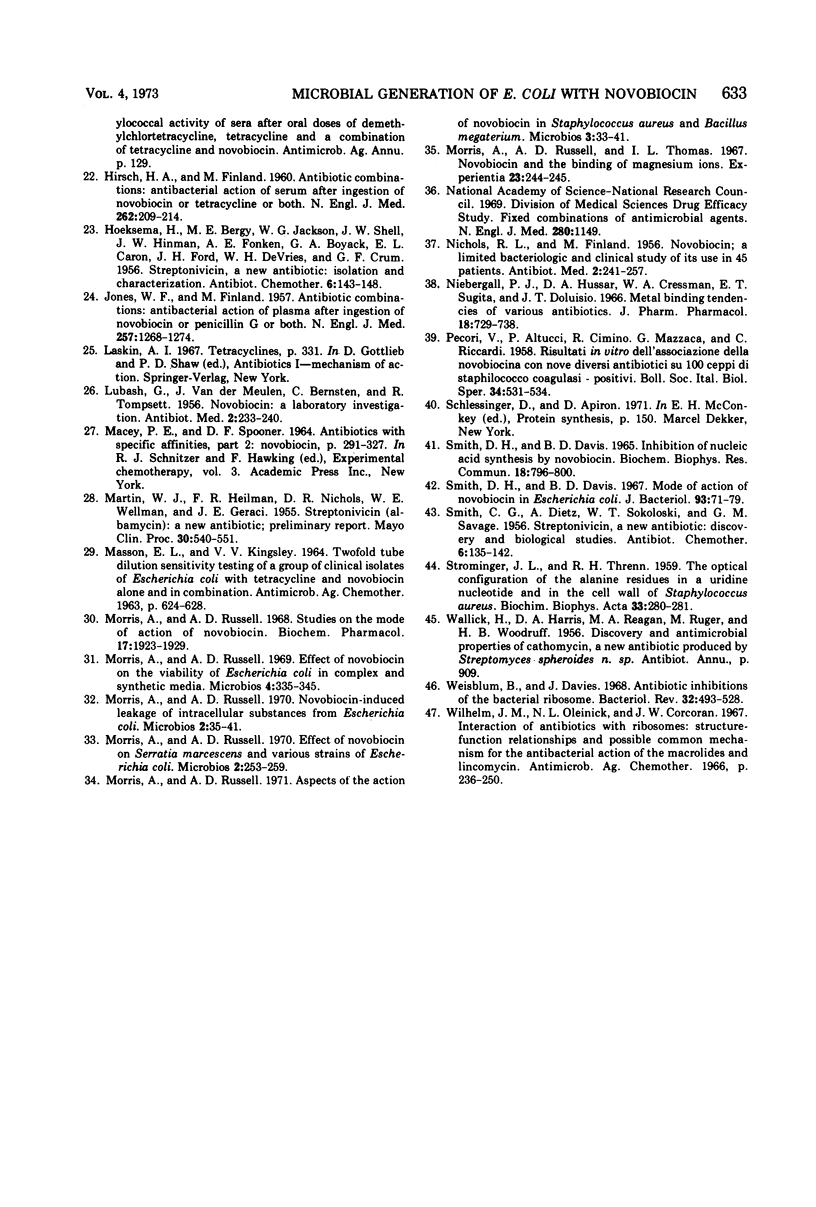
Selected References
These references are in PubMed. This may not be the complete list of references from this article.
- ANTON A. H. A drug-induced change in the distribution and renal excretion of sulfonamides. J Pharmacol Exp Ther. 1961 Dec;134:291–303. [PubMed] [Google Scholar]
- ANTON A. H. The relation between the binding of sulfonamides to albumin and their antibacterial efficacy. J Pharmacol Exp Ther. 1960 Jul;129:282–290. [PubMed] [Google Scholar]
- ATKINS J. L. Novobiocin-tetracycline in the treatment of ear, nose and throat infections. Can Med Assoc J. 1960 Oct 22;83:909–911. [PMC free article] [PubMed] [Google Scholar]
- Allwood M. C., Russell A. D. Thermally induced changes in the physical properties of Staphylococcus aureus. J Appl Bacteriol. 1969 Mar;32(1):68–78. doi: 10.1111/j.1365-2672.1969.tb02190.x. [DOI] [PubMed] [Google Scholar]
- BROCK T. D., BROCK M. L. Effect of novobiocin on permeability of Escherichia coli. Arch Biochem Biophys. 1959 Nov;85:176–185. doi: 10.1016/0003-9861(59)90461-8. [DOI] [PubMed] [Google Scholar]
- BROCK T. D. Effects of magnesium ion deficiency on Escherichia coli and possible relation to the mode of action of novobiocin. J Bacteriol. 1962 Oct;84:679–682. doi: 10.1128/jb.84.4.679-682.1962. [DOI] [PMC free article] [PubMed] [Google Scholar]
- BROCK T. D. Magnesium binding as an explanation of the mode of action of novobiocin. Science. 1962 Apr 27;136(3513):316–317. doi: 10.1126/science.136.3513.316. [DOI] [PubMed] [Google Scholar]
- BROCK T. D. Studies on the mode of action of novobiocin. J Bacteriol. 1956 Sep;72(3):320–323. doi: 10.1128/jb.72.3.320-323.1956. [DOI] [PMC free article] [PubMed] [Google Scholar]
- ELLIOTT H. J., HALL W. H. Studies on synergism with twelve antibiotics against thirty hospital strains of Staphylococcus aureus. J Lab Clin Med. 1957 Aug;50(2):242–249. [PubMed] [Google Scholar]
- FINLAND M., NICHOLS R. L. Current therapeutics. CXIV. Novobiocin. Practitioner. 1957 Jul;179(1069):84–92. [PubMed] [Google Scholar]
- GARROD L. P., WATERWORTH P. M. Behaviour in vitro of some new antistaphylococcal antibiotics. Br Med J. 1956 Jul 14;2(4984):61–65. doi: 10.1136/bmj.2.4984.61. [DOI] [PMC free article] [PubMed] [Google Scholar]
- Garrett E. R., Heman-Ackah S. M. Microbial kinetics and dependencies of individual and combined antibiotic inhibitors of protein biosynthesis. Antimicrob Agents Chemother. 1973 Nov;4(5):574–584. doi: 10.1128/aac.4.5.574. [DOI] [PMC free article] [PubMed] [Google Scholar]
- Garrod L. P. Antibiotic mixtures. S Afr Med J. 1965 Jul 24;39(27):607–610. [PubMed] [Google Scholar]
- HIRSCH H. A., FINLAND M. Antibiotic combinations: antibacterial action of serum after ingestion of novobiocin or tetracycline or both. N Engl J Med. 1960 Feb 4;262:209–214. doi: 10.1056/NEJM196002042620501. [DOI] [PubMed] [Google Scholar]
- JONES W. F., Jr, FINLAND M. Antibiotic combinations; antibacterial action of plasma after ingestion of novobiocin or penicillin G or both. N Engl J Med. 1957 Dec 26;257(26):1268–1274. doi: 10.1056/NEJM195712262572604. [DOI] [PubMed] [Google Scholar]
- LUBASH G., VAN DER MEULEN J., BERNTSEN C., Jr, TOMPSETT R. Novobiocin: a laboratory investigation. Antibiotic Med Clin Ther (New York) 1956 Apr;2(4):233–240. [PubMed] [Google Scholar]
- MARTIN W. J., HEILMAN F. R., NICHOLS D. R., WELLMAN W. E., GERACI J. E. Streptonivicin (albamycin): a new antibiotic; preliminary report. Proc Staff Meet Mayo Clin. 1955 Nov 16;30(23):540–551. [PubMed] [Google Scholar]
- Morris A., Russell A. D. Aspects of the action of novobiocin on Staphylococcus aureus and Bacillus megaterium. Microbios. 1971 Jan;3(9):33–41. [PubMed] [Google Scholar]
- Morris A., Russell A. D. Studies on the mode of action of novobiocin. Biochem Pharmacol. 1968 Sep;17(9):1923–1929. doi: 10.1016/0006-2952(68)90108-1. [DOI] [PubMed] [Google Scholar]
- Morris A., Russell A. D., Thomas I. L. Novobiocin and the binding of magnesium ions. Experientia. 1967 Apr 15;23(4):244–245. doi: 10.1007/BF02135659. [DOI] [PubMed] [Google Scholar]
- NICHOLS R. L., FINLAND M. Novobiocin; a limited bacteriologic and clinical study of its use in forty-five patients. Antibiotic Med Clin Ther (New York) 1956 Apr;2(4):241–257. [PubMed] [Google Scholar]
- Niebergall P. J., Hussar D. A., Cressman W. A., Sugita E. T., Doluisio J. T. Metal binding tendencies of various antibiotics. J Pharm Pharmacol. 1966 Nov;18(11):729–738. doi: 10.1111/j.2042-7158.1966.tb07794.x. [DOI] [PubMed] [Google Scholar]
- PECORI V., ALTUCCI P., CIMINO R., MAZZACCA G., RICCARDI C. Risultati in vitro dell'associazione della novobiocina con nove diversi antibiotici su 100 ceppi di stafilococco coagurasi-positivi. Boll Soc Ital Biol Sper. 1958 Jun 15;34(11):531–534. [PubMed] [Google Scholar]
- STROMINGER J. L., THRENN R. H. The optical configuration of the alanine residues in a uridine nucleotide and in the cell wall of Staphylococcus aureus. Biochim Biophys Acta. 1959 May;33(1):280–281. doi: 10.1016/0006-3002(59)90538-4. [DOI] [PubMed] [Google Scholar]
- Smith D. H., Davis B. D. Mode of action of novobiocin in Escherichia coli. J Bacteriol. 1967 Jan;93(1):71–79. doi: 10.1128/jb.93.1.71-79.1967. [DOI] [PMC free article] [PubMed] [Google Scholar]
- Weisblum B., Davies J. Antibiotic inhibitors of the bacterial ribosome. Bacteriol Rev. 1968 Dec;32(4 Pt 2):493–528. [PMC free article] [PubMed] [Google Scholar]
- Wilhelm J. M., Oleinick N. L., Corcoran J. W. Interaction of antibiotics with ribosomes: structure-function relationships and a possible common mechanism for the antibacterial action of the macrolides and lincomycin. Antimicrob Agents Chemother (Bethesda) 1967;7:236–250. [PubMed] [Google Scholar]


